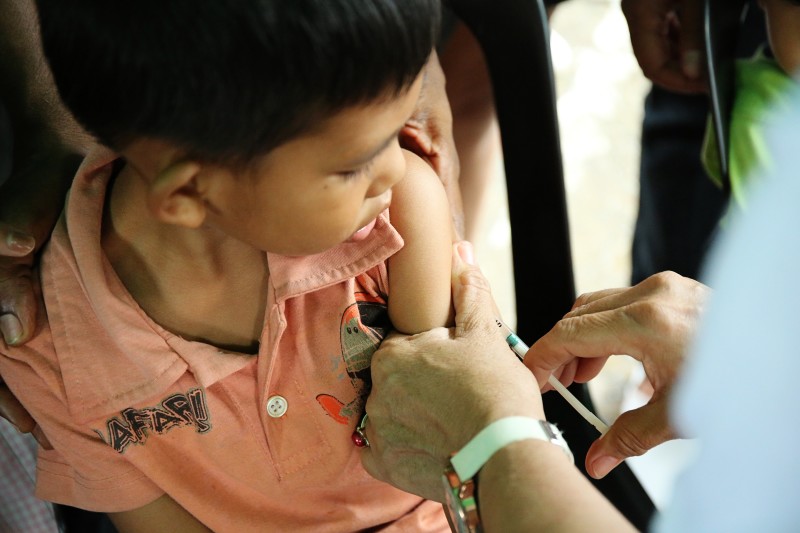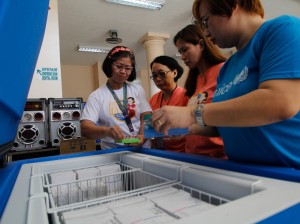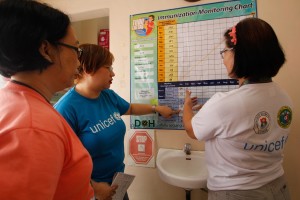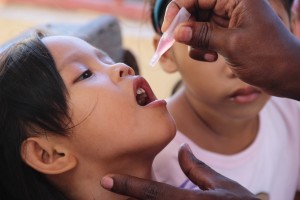
A boy gets vaccinated for measles-rubella during a mass immunization campaign in Region VIII, which Unicef supported. UNICEF PHOTO
New York/Manila – Unicef procured 2.5 billion doses of vaccines to children in nearly 100 countries in 2016, reaching almost half of the world’s children under the age of five. The figures, released during World Immunization Week, make Unicef the largest buyer of vaccines for children in the world.
In the Philippines, Unicef procured $33 million worth of vaccines in 2015 and 2016. The UN children’s agency also dedicated $1.5 million worth of technical assistance and supplies to strengthen immunization in urban poor and conflict areas to reach the most disadvantaged children.

A Unicef staff member inspects vaccines with volunteer health workers at a government health center in Happyland, a slum area in Manila. UNICEF PHOTO
Nigeria, Pakistan and Afghanistan, the three remaining polio-endemic countries, each received more doses of vaccines than any other country, with almost 450 million doses of vaccines procured to children in Nigeria, 395 million in Pakistan and over 150 million in Afghanistan. Unicef is the lead procurement agency for the Global Polio Eradication Initiative.
Access to immunization has led to a dramatic decrease in deaths of children under five from vaccine-preventable diseases, and has brought the world closer to eradicating polio. Between 2000 and 2015, under five deaths due to measles declined by 85 per cent and those due to neonatal tetanus by 83 per cent. A proportion of the 47 per cent reduction in pneumonia deaths and 57 per cent reduction in diarrhea deaths in this time is also attributed to vaccines.
Yet an estimated 19.4 million children around the world still miss out on full vaccinations every year. Around two thirds of all unvaccinated children live in conflict-affected countries. Weak health systems, poverty and social inequities also mean that 1 in 5 children under five is still not reached with life-saving vaccines.
The Philippines has achieved a number of successes in immunization. The immunization program has contributed to the reduction in the under-five mortality rates from 58.2 in 1990 to 28 in 2015 (World Bank, 2016). The country has maintained its polio free status since 2000 and will be validated for Maternal Neonatal Tetanus Elimination this year. Increasing government budget has enabled introduction of new vaccines like PCV13, HPV, IPV, Dengue vaccine and Rotavirus in selected areas. In 2018, Japanese Encephalitis vaccine will also be introduced.

A Unicef staff member and health workers discuss immunization coverage in Happyland, a slum area in Manila. UNICEF PHOTO
In terms of policy, a law has been enacted that mandates free immunization services for infants and children in all government hospitals and health centers. The provision of immunization services has now been expanded to school children, adolescents and senior citizens.
Despite these achievements, the Philippines has many opportunities for improving the immunization program.
“In the Philippines, there are still millions of unvaccinated children. Children in conflict areas and children in urban poor communities face hazards including overcrowding, unsafe water, air pollution, inadequate sanitation and garbage collection and lack of access to quality health services including vaccines. We must work together to reach all children everywhere, with a particular focus on the most underserved parts of the population,” Unicef Philippines Deputy Representive Julia Rees says.
In the Philippine National Demographic Health Survey of 2013, only 68.5 per cent of children 12-23 months were fully immunized, a drop from 79.5 per cent in 2008. The national immunization coverage for all Vaccine Preventable Diseases (VAPD) is decreasing.

A child receives oral polio vaccine during a mass immunization campaign in Tanauan, Leyte, four weeks after Typhoon Yolanda hit the area. UNICEF PHOTO
“All children, no matter where they live or what their circumstances are, have the right to survive and thrive, safe from deadly diseases,” said Dr. Robin Nandy, Chief of Immunization at Unicef. “Since 1990, immunization has been a major reason for the substantial drop in child mortality, but despite this progress, 1.5 million children still die from vaccine preventable diseases every year.”
Inequalities persist between rich and poor children. In countries where 80 per cent of the world’s under-five child deaths occur, over half of the poorest children are not fully vaccinated. Globally, the poorest children are nearly twice as likely to die before the age of five as the richest.
“In addition to children living in rural communities where access to services is limited, more and more children living in overcrowded cities and slum dwellings are also missing out on vital vaccinations,” said Nandy. “Overcrowding, poverty, poor hygiene and sanitation as well as inadequate nutrition and health care increase the risk of diseases such as pneumonia, diarrhea and measles in these communities; diseases that are easily preventable with vaccines.”
By 2030, an estimated 1 in 4 people will live in urban poor communities, mainly in Africa and Asia, meaning the focus and investment of immunization services must be tailored to the specific needs of these communities and children, UNICEF said.
In the Philippines, Unicef is helping the government reach all children by advocating to leaders at all levels of government to invest in health care to protect children from diseases.
Read Next
EDITORS' PICK
MOST READ
Don't miss out on the latest news and information. 












